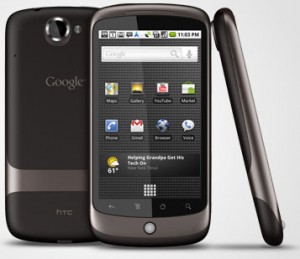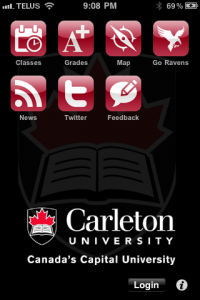M-Learning
 I have a Google HTC Nexus phone and I use it for many things, including: email, texting, reading blogs, making to-do lists, setting alarms, playing games, taking pictures, recording and watching videos, getting directions using Google Maps, and I also enjoy using the Mobi app to connect to QR codes. I only recently bought a data plan for my phone (as it ended up being less expensive), since I don`t need to commute anywhere very often at this time in my life I am quite comfortable connecting to a WiFi connection at home or at a coffee shop, etc. If I do end up needing something where I won`t have WiFi access, like making a grocery list or getting directions from Google Maps, I can just download everything before I leave my house.
I have a Google HTC Nexus phone and I use it for many things, including: email, texting, reading blogs, making to-do lists, setting alarms, playing games, taking pictures, recording and watching videos, getting directions using Google Maps, and I also enjoy using the Mobi app to connect to QR codes. I only recently bought a data plan for my phone (as it ended up being less expensive), since I don`t need to commute anywhere very often at this time in my life I am quite comfortable connecting to a WiFi connection at home or at a coffee shop, etc. If I do end up needing something where I won`t have WiFi access, like making a grocery list or getting directions from Google Maps, I can just download everything before I leave my house.
It has been about two years since I got this phone and I still like it, mostly because it works great, especially for m-learning. It is still surprisingly quite fast, extremely reliable and it easily fulfills all of my m-learning needs. Navigating and browsing the web is seamless, as the phone is able to quickly adjust the page so that it fits the screen properly and it can be modified as needed. Another feature of the phone that I really like is the auto-correct. I have never seen a phone that is as flawless as this one, and I`ve seen quite a few as my husband changes his phone every three months (and none of them have very good auto-correct 🙂
 Since I just graduated from Carleton a little over a year ago, I thought I would evaluate their new mobile app . This app is directed to Carleton students, providing them with a place to access class schedules, check grades, find a class or exam location with a GPS-enabled campus map, and access the latest news and events. It is also available for both Android and iPhone users, making it accessible to a wide number of people. Carleton has WiFi in every building, so I imagine that if users didn’t want to use their data they could connect to the WiFi on campus. To make this more accessible they could provide a link on the app to connect to the WiFi on campus. I think the main highlight of this app, is the GPS-enabled campus map and locations of exams, I would have downloaded and used this app if I was still at Carleton, as I’ve been lost once or twice on the Carleton campus and have forgotten to write down my exam location from time to time, especially when I was new to the school. Also I see that they have a transit app, which is really useful since they have a free shuttle bus service between Carleton and the University of Ottawa, as Ottawa U is located downtown and is a service I used if I didn’t want to drive to school. I don’t really see there being a competing method of teaching, as you’re not really teaching the students anything.
Since I just graduated from Carleton a little over a year ago, I thought I would evaluate their new mobile app . This app is directed to Carleton students, providing them with a place to access class schedules, check grades, find a class or exam location with a GPS-enabled campus map, and access the latest news and events. It is also available for both Android and iPhone users, making it accessible to a wide number of people. Carleton has WiFi in every building, so I imagine that if users didn’t want to use their data they could connect to the WiFi on campus. To make this more accessible they could provide a link on the app to connect to the WiFi on campus. I think the main highlight of this app, is the GPS-enabled campus map and locations of exams, I would have downloaded and used this app if I was still at Carleton, as I’ve been lost once or twice on the Carleton campus and have forgotten to write down my exam location from time to time, especially when I was new to the school. Also I see that they have a transit app, which is really useful since they have a free shuttle bus service between Carleton and the University of Ottawa, as Ottawa U is located downtown and is a service I used if I didn’t want to drive to school. I don’t really see there being a competing method of teaching, as you’re not really teaching the students anything.
The next app I decided to evaluate is the Grace App for Autism. This app is designed to assist individuals with autism and other speech difficulties like apraxia and aphasia to communicate by using pictures attached to a board, making sentences and questions. This app replaces the traditional Velcro communication books, which I feel is a good thing. What is beneficial about this app compared to the traditional Velcro books, is it is not as bulky to carry around, you also don’t have to worry about losing the Velcro images and you can add as many images as you want, allowing for a much wider range of choice when communicating. Grace apps also says that users have learned to take pictures of what they see and share it independently, as a result of using this app. Currently this app is only available for iPhones and iPads, if it was compatible with Android phones and tablets this app may be more widely adopted. This app is also currently $37.99, which is relatively high, but in my experience, this is a worthwhile investment for caregivers and parents.
Posted in: Week 11: Mobiles
David William Price 8:39 pm on November 18, 2011 Permalink | Log in to Reply
Thanks for sharing about your mobile, and your reviews.
As you noted, WIFI is a way to get around expensive data plans. There are even people who do voice-over-IP (VOIP) calls over WIFI instead of using minutes / long distance!
THe Carleton App is a great example of performance support… mlearning that provides you data you need when you need it. How might you extend the performance support concept for your own work when you’re on the go?
The Grace App is another amazing performance support app that integrates many mobile affordances. Arguably it helps teach people to communicate in new ways, and to use the picture-taking capability to expand and sharpen “vocabulary”. This is a great example of sharing a mobile… one person creates communication and shares it with another person to understand what is being communicated. Together, the communicator and the audience and working together to understand the message.
How might this concept be extended for other situations? I’ve often thought a performance support for resolving conflicts would be helpful and usable in similar ways. By running through the process in the mobile with its coaching and scaffolding, people would learn how to turn conflict into opportunities to enrich their relationships and resolve problems rather than fight over them.